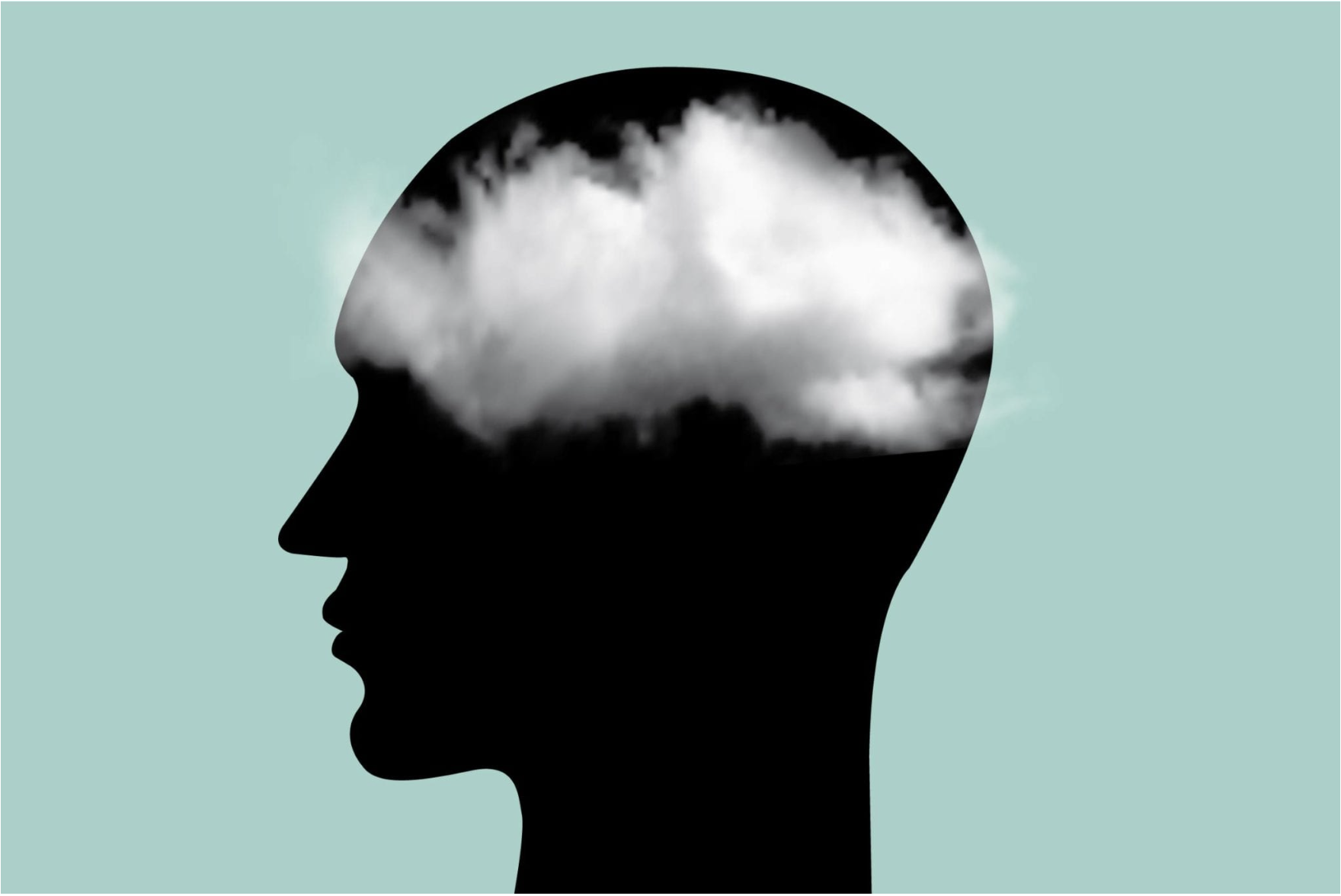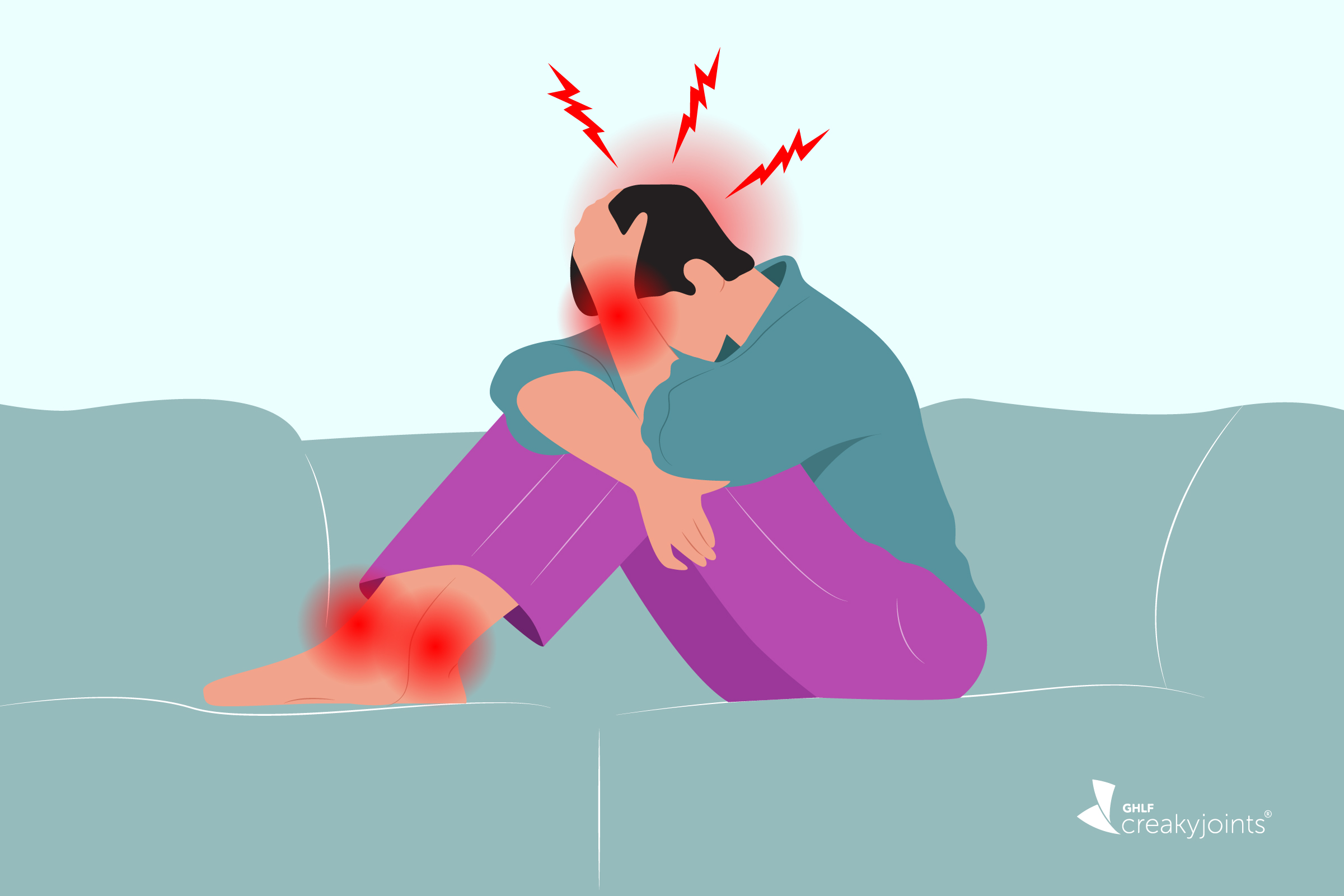The Up-End Migraine Project reveals key gaps in episodic migraine care, aiming to drive change and improve treatment options for patients through insights from both providers and patients.
What These Patient Advocates Want You to Know About Migraine
What These Patient Advocates Want You to Know About Migraine
June 6, 2022
Sarah Shaw
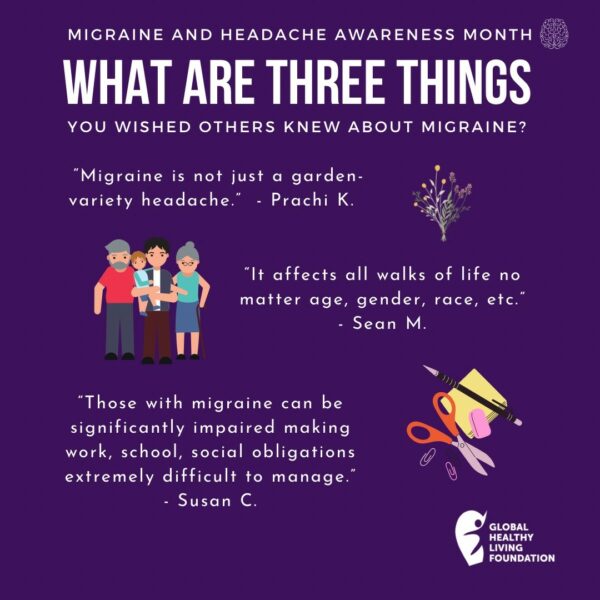
Migraine is a very stigmatized disease and is often thought of as “just a bad headache.” In an effort to help reduce stigma, increase empathy, and spread awareness about what it’s like to live with this neurological disease, we asked members of the Global Healthy Living Foundation/CreakyJoints community: “If there was one thing you wish others knew about your migraine(s), what would it be?”
The idea was inspired by our very first Migraine Canada Patient Council Patient council, during which Sean M., Prachi K., and Susan C. shared three things each.
Sean M. wanted people to know:
- “It’s more than ‘just a headache’…there is so much more to it than head pain.”
- “It affects all walks of life no matter age, gender, race, etc.”
- “When migraine is portrayed and trivialized in media, tv, movies, your own comments etc., it actually harms those who seek treatment and battle this disease. For example, ‘I can’t tonight, I have a migraine’ is the same as ‘I have to wash my hair.’ How many times do we hear this comment or see it on TV said in passing. It makes people think it’s an excuse.”
Prachi K. wanted people to understand that:
- “Migraine is not just a garden-variety headache.”
- “We need better migraine education among primary care physicians.”
- “We need accessible patient education re. migraine (pathophysiology, treatments, disease burden et al.).”
Susan C. wants more people to see that:
- “Migraine is not a headache. That headache is only one symptom and many with migraine don’t have headache during attacks at all.”
- “Those with migraine can be significantly impaired making work, school, social obligations extremely difficult to manage.”
- “Finding treatment that works to reduce disability/symptoms can be a lengthy difficult process that is unique to the individual and treatment rarely ‘cures’ migraine symptoms but rather reduces their severity/instance.”
Let’s take this opportunity this Migraine and Headache Awareness month — and beyond — to get real about how migraine is misunderstood and how it impacts your daily life. You can hopefully take inspiration from these honest and inspiring responses below.
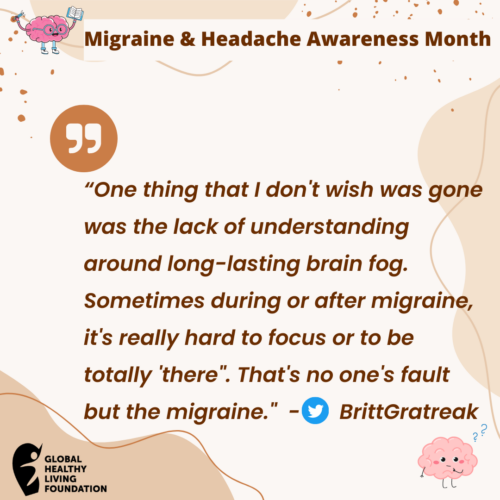
My Migraine Causes Brain Fog and Fatigue
A lot of people associate a migraine attack with just head pain. Migraine is a complex neurological disease and does not just present with head pain. For some patients, brain fog and fatigue can present before, during, and after a migraine attack.
- “A lot of us hide the pain really well. Also, people don’t understand the brain fog many of us experience during and after a migraine.” — @Schwinnjessica
- “It messes up my ability to speak or understand what people are saying to me because my brain feels completely fogged up. It drains my energy to the point where all I can do is sleep.” — @isaiahhzion
- “It’s not always pain that’s debilitating. For me, the fatigue is the biggest challenge to manage.” — @CSWhiteMD
- “Sometimes I experience difficulty speaking/thinking, but that’s also a side effect of the meds I take for it. So if I get a migraine before, say a job interview, I have to do the world’s worst cost/benefit analysis.” — @jenwith_1_n

Just Because I Don’t Look Like I’m in Pain Doesn’t Mean I Am Okay
Migraine for the most part is an invisible illness. (There are certain kinds of migraine, like hemiplegic migraine, that can present more visible symptoms.) People can’t “see” the pain you’re in and often make assumptions that you’re not in pain because you “look fine.” A lot of people living with migraine are suffering in silence as they push through their day, so please be gentle and kind as you interact with others.
- “That just because I don’t ‘look’ like I’m in pain — doesn’t mean I feel good. I am almost ALWAYS feeling migraine attack symptoms. Chronic migraine equals emphasis on the chronic. It’s about learning to adapt my life to avoid migraine attacks. There’s no cure.” — @carmenrfiallo
- “That just because I’m moving around and functional doesn’t mean I’m not in pain. Sure, I know how to ‘push through it,’ and do so often, but that doesn’t invalidate how bad I’m hurting.” — @LunaR0sette
- “That most of the time, I’m faking feeling good.” — @FassJef
- “It’s not easy to just ‘take a day off’ when I’m in pain. I’m in pain almost every day. I operate on how well I can function.” — @TezGO4
- “I have no control over where, when, or how painful they are going to be. No, I don’t know how long they’re gonna last and I do fancy myself a migraineur so yes there are sometimes I can function through them.” — @AnemoneWhispers
- “Just because I seem ‘OK” only means the pain and symptoms are at a lower level at the moment but it could skyrocket to depressive bound to under the pillow and no light and/or noise at any moment.” — @MichMarieW3
- “Just because I appear to be functioning it doesn’t make it any less severe. I don’t always need to lie in a dark room.” — @fleuroriginale

It’s Not Just a Headache
Migraine is so much more than just a bad headache that you get from time to time. Migraine can be debilitating and present multiple symptoms such as light sensitivity, sound sensitivity, nausea, temporary blindness, and in some cases, dizziness and stroke-like symptoms. What’s more, it can last for hours to days at a time.
- “The prodrome and postdrome phases can be just as debilitating as the attacks themselves. Especially the fatigue, nausea, and brain fog. Also knowing that daily feelings of frustration, sadness, annoyance, and disappointment are perfectly normal responses to chronic pain.” — @bunnyandthegirl
- “I wish people understood that symptoms can be systemic like GI issues, mobility issues with balance, etc. This is something that as a patient I struggled to learn and understand, and I’ve only recently begun to understand some of my other migraine symptoms beyond head pain.” — @hayleyphd
- “That they are the cause of all those times I threw up in the street in the middle of the day in front of everyone when I couldn’t make it home in time.” — @miscfrog
- “That it’s not just a headache; it’s also vomiting, nausea, dizziness, sound/smell/light sensitivity so intense it hurts to move in addition to feeling like there’s a small angry creature trying to force its way out of my skull through my eye socket.” — @tuesdaymidnight
- “Migraine is not ‘just a headache.’ I often have symptoms like skin pain (allodynia), brain fog, and sensory sensitivities without significant head pain.” — @LExploitable
- “The full body effect and brain functionality, or lack there of, not just how it affects your head.” — @invigor8life2
- “That when I say I cannot see, it means I actually can’t see, and I don’t currently have any blind skills. I don’t know why people think I would say that if it wasn’t true but can’t tell you how many times I’ve heard ‘oh I didn’t realize your vision is fully obstructed’ and I’m like…yes.” — @lizziechad
- “I often lose a lot of my vision before the splitting pain starts — it’s super annoying because one of my triggers is sunlight.” — @shashunanu
- “1) My migraine ‘may be gone,’ but it is usually not ‘over’ for two to three days. 2) My hemiplegia migraines can look like strokes. 3) Migraines do not equal headache. Sometimes, I don’t even have head pain. 4) They can exacerbate my psych conditions and vice versa.” — @AceonFire77
- “On the days I’m not in 8/10 pain I’m more than likely experiencing other symptoms, in recovery from an attack or both. I’m tired and probably annoyed.” — @glorious_floria

There Are Different Phases and Severity of Migraine
There are also many different phases of a migraine attack, such as pre-drome and postdrome where you can still be dealing with symptoms such as aura, brain fog, and fatigue. There’s also different kinds of migraine attacks and headache like vestibular, hemiplegic migraine, and cluster headaches.
- “That the attack phase of migraine leaves me bed bound in pain is only about 70 percent of my chronic migraine life. So just because I’ve managed to get out of bed and do ‘stuff’ doesn’t mean I’m not in some sort of pain. I ALWAYS have some sort of headache; it doesn’t go away.” — @bunnyandthegirl
- “Yes; we really can’t talk, walk, work, socialize, etc. with a migraine. It is that bad.” — @migraineColl
- “That it isn’t just a few hours until meds kick in and it isn’t just a one-day ordeal. I get a migraine ‘hangover’ for days, usually three days. Nausea and head/neck pain take a minute to subside. The older I get the harder it is to function with a migraine too. Migraine equals bed day now.” — @MonicaSupportby
- “The depression that comes after. I don’t know about anyone else, but postdrome phase is a psychological nightmare for me.” — @LindsayPatton
- “Migraine rest days are not ‘days off’ by any means. They can be agony, dark rooms, nausea, puking, spending hours in a bathroom. We often can’t look at our phones or screens, while feeling crappy about ourselves for not being able to do things we need to do.” — @BrittGratreak
- “What a vestibular migraine is, how you can have two types of migraine at the same time. ‘Chronic daily’ literally means just that.” — @Tinacblanchard
- “The severity of chronic migraine — this is not just ‘she gets headaches.’ And how extremely easy it is to trigger a migraine. Tiny things loved ones can do to help you avoid triggers can be hugely helpful, especially avoiding certain sounds.” — @MissDS17
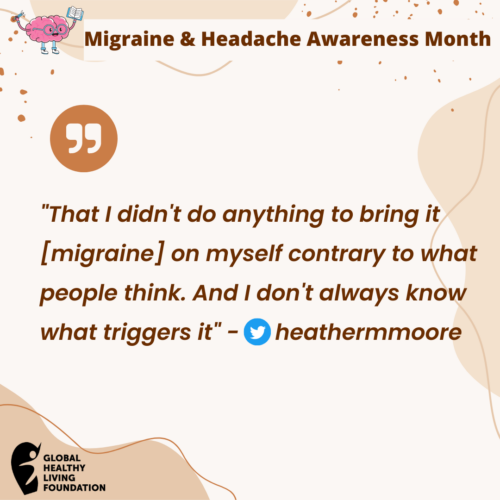
Migraine Is Not Your Fault
Migraine is a complex neurological disease. You didn’t do anything to cause them, and they certainly are not your fault.
- “For me, screens don’t trigger them. I’m fed up with people saying ‘Oh, it’s because you’re on your phone/iPad so much. I get two types, and my more frequent is from too much cbt [cerebrospinal fluid] in my skull putting pressure on my brain (technically not ‘migraine’).” — @PawsitivelyK
- “That I didn’t do anything to bring it on myself contrary to what people think. And I don’t always know what triggers it.” — @heathermmoore
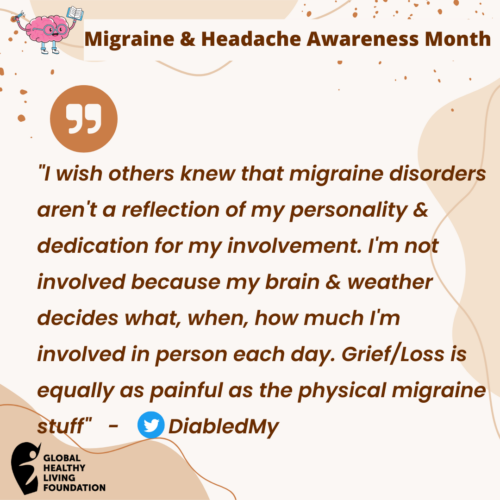
We’re Not Flaky, Our illness Is
People living with migraine disease are often very misunderstood by peers, co-workers, and family members. It can be very difficult to make plans due to the unpredictability of when a migraine attack will strike.
- “I wish others knew the migraine disorders aren’t a reflection of my personality and dedication for my involvement. I’m not involved because my brain and weather decides what, when, and how much I’m involved in person each day. Grief/loss is equally as painful as the physical migraine stuff.” — @DiabledMy
- “I still want to be invited out but also have to be honest with myself and my friends/family that I may need to cancel if a migraine attack strikes (or if I have to leave early). I still desperately want to engage and hangout, but it just may need to be in a different way that what they’re used to.” — @migrainesallday
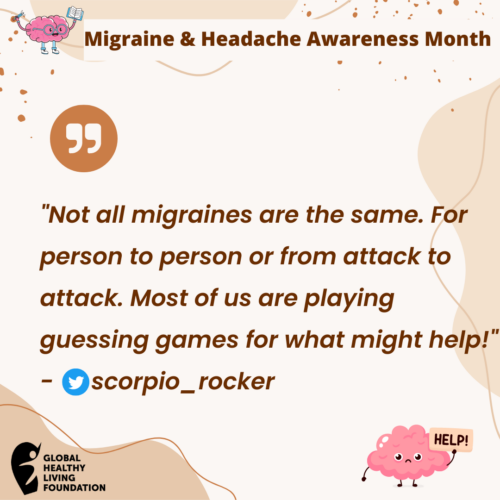
Each Migraine Patient Is Different
Migraine patients receive a lot of unsolicited advice from people who assume that the migraine you’re experiencing can simply go away with over-the-counter (OTC) medicine or can be solved with a wonky remedy like putting a banana peel on their head. One size does not fit all for migraine treatment either. One medical treatment that works for you, might not work for someone else so always keep that in mind.
- “Please don’t apply your personal migraine/pain experience to me, especially in an effort to dismiss the severity of my experience. While it’s great that you can keep a lid on things without OTC meds, chiropractic care, herbal supplements, etc…I can’t. We’re all different and valid.” — @catballouboo
- “That my migraine is not exactly like your sister’s migraine. In other words — no two are alike.” — @robotoswonthelp
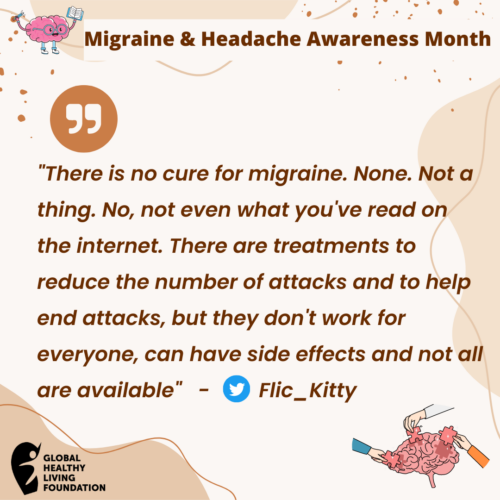
There’s Currently No Cure, Just Treatments
Migraine is a complex neurological disease with no cure. While we’ve come a long way with new medical treatments being released in the last few years, there is still not a miracle drug. Plus, not everyone has access to these treatments.
- “How treatment actually works; how we don’t treat to zero pain; how we can’t treat every pain; how treatments have their own side effects that can be equally debilitating. My friends struggle most with the ‘oh but you took your medicine’ and that doesn’t mean what you think.” — @HemingwayMuse
- “No cure. Limited research if any research. Sure, grateful there’s new understanding of CGRP meds and that’s a band aid for understanding the neurology and physiology of migraine disorders.” — @DiabledMy
- “There is not a cure. I do not take medicine and the migraine goes away. It is not a chest infection cured by antibiotics. Yes, I’ve taken my meds, but I will still get attacks. No; it doesn’t mean each attacks put me back to square one. Nor that meds don’t work. FML.” — @highpoh
- “That not all chronic migraine patients have access to care. There are many, like myself, who have to scrape by with at-home treatments due to lack of access to healthcare. Much of the conversation in migraine circles involve doctors, medicine and the like. Not systemic changes.” — @IndecentAdvocado
Migraine Resources
The Global Healthy Living Foundation has resources to help you navigate your migraine disease or help you as a family/caregiver/friend of a person you care about who has migraine understand what they’re going through.
- Talking Head Pain, a podcast that confronts pain head on. Through personal conversations with fellow migraine and headache patients, host Joe Coe explores the challenges, hopes, and triumphs of his guests. Tune into Talking Head Pain and hear how people like you have found ways to get relief or listen to our audio guides that cover everything from getting a migraine diagnosis to navigating migraine on the job
- A Patient’s Guide to Migraine, a free downloadable guide that offers clear, trusted information to make sense of all the treatment choices for migraine disease.
- A Caregivers Guide to Migraine, a free downloadable guide that educates caregivers about treatment options available to their loved ones to prevent and manage migraine attacks.
Want to Get More Involved with Patient Advocacy?
If you’re interested in getting involved in migraine or BIPOC advocacy at GHLF, you can email Sarah here. Your voice in advocacy matters. The 50-State Network is the grassroots advocacy arm of CreakyJoints and the Global Healthy Living Foundation, comprised of patients with chronic illness who are trained as health care activists to proactively connect with local, state, and federal health policy stakeholders to share their perspective and influence change. If you want to effect change and make health care more affordable and accessible to patients with chronic illness, learn more here.
SUBSCRIBE TO GHLF
RELATED POST AND PAGES
_
Was this article helpful?
YesNo


